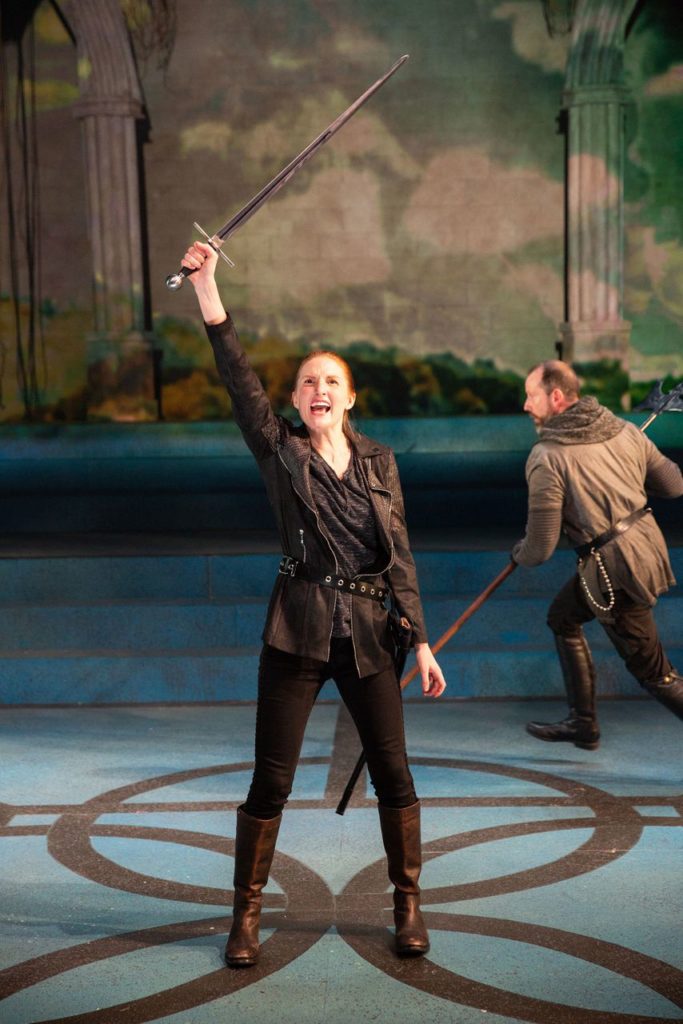By Ellen Wilson Dilks | February 12, 2019

Delaware Theatre Company (DTC) continues their current season with a production of Chelsea Marcantel’s feminist reworking of George Bernard Shaw’s SAINT JOAN. Directed by Bud Martin, the production features DTC favorite Claire O’Malley in the title role, and runs until February 24, with performances Tuesdays through Sundays.
“O God that madest this beautiful earth, when will it be ready to accept thy saints? How long, O Lord, how long?”
SAINT JOAN is Shaw’s telling of the 15th century French farm girl who became the warrior savior of her country; it premiered in 1923—three years after Joan was canonized. In his preface, the playwright said “It is what men do at their best, with good intentions, and what normal men and women find that they must and will do in spite of their intentions, that really concern us.” He describes Joan as a rebel. She fights against the stringent authority of the Catholic Church and the inequities of the feudal system. In a time when there was no separation between church and state, this peasant girl dared to speak out and stand up for her beliefs. The story of Joan of Arc has received many adaptations, including film, opera and sound recordings.
Marcantel’s version of SAINT JOAN focuses on Joan’s pushing of societal boundaries as to what a woman’s place was in the world. Marcantel has said in interviews that she grew up (like most young girls) with only male heroes as shining examples. “To be female is to be meek, but saints are unapologetically angry.” She wanted to make Joan even more of a driving force in the play, to lessen the male characters dominance of the story. She hopes to give girls—and women—the inspiration and freedom to become heroes. In her version, not only is Joan given more focus, but the voices of the two Saints Joan heard are embodied by two actresses who help tell the story. Marcantel also brings great humor to the story—as well as great humanity.
“You came clothed with the virtue of humility; and because God blessed your enterprises accordingly, you have stained yourself with the sin of pride.”
Director Bud Martin, excited by this new take on Shaw’s classic, has assembled a strong cast of some of the areas best actors to bring the play to life. His direction is sure, with well thought out staging; although I must say the pacing lagged at times. That will, I’m sure, improve as the run progresses. Martin makes wonderful use of Colin McIlvaine’s visually stunning set, with its varied levels and multiple entrances. McIlvaine has two towering walls of Gothic arches angling from downstage to up center—with the scrim across the back used for some impressive projections created by Nick Hussong and Joey Moro. The arches are “broken” in spots, which to me represented the broken state of France’s political scene. McIlvaine employs curtains of ropes on each level that were used to great effect; my one concern was that when they were opened or closed, the swaying could be distracting. Thom Weaver’s lighting design is evocative and creates the right moods as needed. Supporting this is Michael Kiley’s dramatic soundscape, which helps build the tension and enhances the chaos of the battle scenes. Millie Hibel’s costumes are a mix of contemporary and medieval—which I can only assume is to send the message that Joan’s story is still current.
The cast consists of seasoned performers who are known at theatres throughout the region. All play multiple roles, so that this large story is told by eight actors. As the embodiments of Saints Margaret and Catherine (two of Joan’s voices), Mary Toumanen and Tai Verley bring just the right note of “otherworldliness.” They also nicely serve as agents to enhance the action. Sean Michael Bradley (who also created the fight choreography) is solid as Poulengey (a young soldier impressed by Joan’s conviction and fearlessness), Page, Dunois and Ladvenu, creating subtle differences with each character. The always interesting Charlie DelMarcelle deftly morphs from Baudricourt (who is totally frustrated by Joan’s persistence) to Bluebeard to Lieutenant to Cauchon (who is vicious in his determination to see Joan burned at the stake). Michael Doherty delights as a spoiled, frivolous Dauphin, then surprises with a turnabout to Stogumber and D’Estivet (clerics determined to damn Joan). Mary Martello brings her strong comedic skills to the roles of the Housekeeper and the Abbess, but lacked some bite as Lady Warwick (who engineers Joan’s capture and downfall. Dan Kern is a strong presence as the Archbishop (a pompous churchman who sees things in black and white only) and the cruelly determined Inquisitor.
“I am not afraid… I was born to do this.”
As the feisty Joan, Claire O’Malley is a dynamo in spite of her small stature—just like Joan. She brings great passion to the role, allowing the viewer a real sense of Joan’s character and her determination. O’Malley’s lovely blend of strength and vulnerability are great to watch. She and Marcantel show that Joan was just a simple peasant girl who believes in the messages sent to her by God through her visions. She was afraid of the task set her, but had unwavering faith that God would provide her the strength and the means to see it through.






